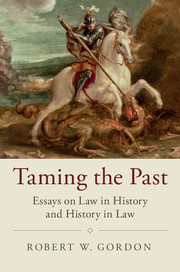Part III - History and Historicism in Legal History and Argument
Published online by Cambridge University Press: 13 July 2017
Summary
[This essay, published in 90 Yale Law Journal 1017 (1981) was written for a Symposium on Legal Scholarship held at Yale Law School in 1981. It was my first attempt to explain the nature of the threat that I believe historicism poses to legal theory and legal reasoning; and to describe the leading ways we have of coping with the threat. Prominent among those ways is what is called here “adaptation theory,” which in “Critical Legal Histories,” the essay that follows, becomes “evolutionary functionalism.”]
- Type
- Chapter
- Information
- Taming the PastEssays on Law in History and History in Law, pp. 181 - 415Publisher: Cambridge University PressPrint publication year: 2017

